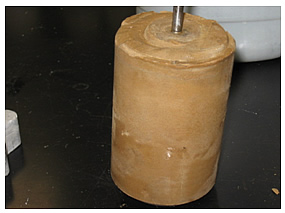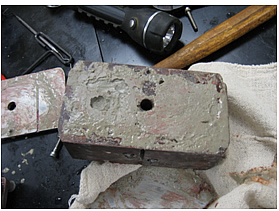One of the basic material requirements in oil and gas well completion operations in Arctic regions where permafrost is present, is the use of a suitable insulating cement that will provide both a good seal to prevent gas leakage and at the same time keep the permafrost interval undisturbed during the production of the oil and gas. Conventional Portland cement has difficulty in setting and performing suitably under Arctic conditions. The freezing and expansion of water in the pores and capillaries of the cement slurry leads to the development of cracks in the structure before the cement is set. In addition, conventional cements do not have sufficiently low thermal conductivity, and are thus not good insulators.
Ceramicrete, the phosphate bonded ceramic borehole cement developed at ANL, may provide an alternative. ANL, in partnership with UAF, proposed to tailor this cement for permafrost regions and demonstrate its application in Alaska. UAF is working with this new material to develop an appropriate "blend" to meet the oil industry's needs.
Results
Tests have been conducted at BJ Services’ Tomball R&D Center using a new formulation of Ceramicrete with and without contamination by Portland cement. These tests have shown positive results for the effective use of Ceramicrete as oilfield cement.
Benefits
The newly developed Ceramicrete is a rapid-setting, strong, pore-free (low-permeability) insulating cement that shows good resistance to corrosion and the effects of freeze-thaw cycles.
If conventional Portland cement is used as oilfield cement on the Alaskan North Slope, it can form water pockets after setting in the annular volume between wellbore and casing. This can lead to loosening of set cement and in turn can affect well integrity.
Ceramicrete tests have shown that the thickening time of Ceramicrete (with and without contamination from Portland cement) is 5 hours, which meets API standards and avoids the formation of water pockets. Hence, Ceramicrete has an ability to provide improved well integrity.
As well, the amount of heat evolved during the setting of the cement slurry in the case of Ceramicrete is less than that for conventional Portland cement. Thus Ceramicrete can also help to reduce shallow gas migration problems associated with cement-induced thawing of the permafrost around the wellbore.
This lightweight cement is also believed to be more efficient for use in shallow arctic completions. This could mean that Ceramicrete will be quite useful in supporting the development of both shallow heavy oil and gas hydrates resources in the Arctic, while protecting the permafrost.
Summary
Annular gas migration during cementing oil and gas wells is a serious problem. Failing to control gas migration can result in gas channeling and costly squeeze jobs. New cementing approaches could help reduce the safety and environmental hazards created by cementing failures.
Project objectives included:
- Formulating and optimizing the ceramic borehole cement for use in permafrost regions.
- Conducting simulated laboratory tests at UAF.
- Collaborating with industry partners to conduct yard tests.
Among the project highlights are the following accomplishments and conclusions:
- Simulations were conducted with “ABAQU’S” software to determine the effect of heat generated during the setting of the Ceramicrete in the annulus and its impact on permafrost.
- The setting time and temperature of Ceramicrete slurry in the annular volume between wellbore and casing was determined to be 3.5 hours and 120 °F.
- Sensitivity analysis was conducted over a range of temperatures (90 °F to 120 °F), and results showed that the thawed zone radius around the wellbore was 8.5 cm after 3.5 hours at 90 °F and 9 cm at120 °F.
- To reduce the heat generated during the setting of cement slurry, tests were carried out with a new formulation of Ceramicrete by BJ Services. The new Ceramicrete formulation showed less heat generation compared with the previous Ceramicrete formulation, which in turn will reduce permafrost thawing.
- The new formulation of Ceramicrete was found to be compatible with Portland cement (95 percent of Ceramicrete and 5 percent of California Portland cement “G” grade), giving it 5 hours of thickening time both with and without Portland cement contamination, which meets API standards.
- Compressive strength tests were carried out by BJ Services with the new formulation of Ceramicrete with and without the contamination of Portland cement. These tests showed that the new Ceramicrete formulation developed sufficient compressive strength (925 psi after 24 hours for Ceramicrete without contamination) for its use as an oilfield cement.
The latest effort at UAF involves conducting tests regarding freezing point measurement, fluidity, compressive strength, thermal conductivity, heat of hydration, and setting time for a slurry of 95 percent Ceramicrete and 5 percent Portland cement.






